
|
xTuple ERP Reference Guide |
The Lot/Serial screen provides a kind of Workbench for managing Lot/Serial records and registrations. The screen may also be used for creating new Lot/Serial Numbers for Items. To manage your Lot/Serial records, use the following screen:
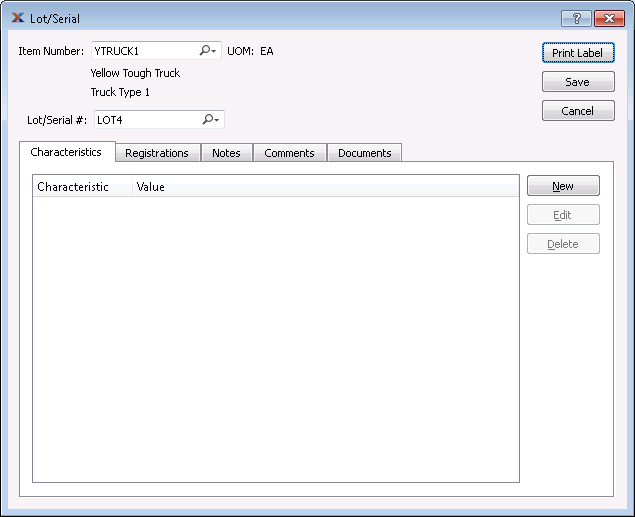
When managing Lot/Serial records, you are presented with the following options:
Enter the Item Number whose Lot/Serial records you want to manage.
Inventory Unit of Measure.
Select a pre-existing Lot/Serial Number for the specified Item. Or create a new Lot/Serial Number if none exists. Keep in mind that any ad hoc Lot/Serial Numbers created here are not traceable. To have traceable Lot/Serial Numbers, the Item must have an Item Site where the control method is either Lot or Serial.
If an Item has Characteristics associated with it, you have the option of linking those Characteristics to a Lot/Serial Number. Characteristics specified for Lot/Serial may also be associated. When associating Characteristics with a Lot/Serial Number, you are presented with the following options:
Display lists the Characteristic name and Value of Characteristics related to the Lot/Serial Number.
To create a new Lot/Serial Characteristic, select the NEW button. The following screen will appear:
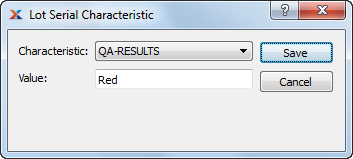
Select a Characteristic from the list of Characteristics designated as being available for use as Item or Lot/Serial Characteristics.
Displays the default Value associated with the Characteristic, but permits you to specify an alternate Value.
You have the ability to register Lot/Serial Numbers—whether for warranty or other purposes. To register a Lot/Serial Number, select the "Register" tab. The following screen will appear:
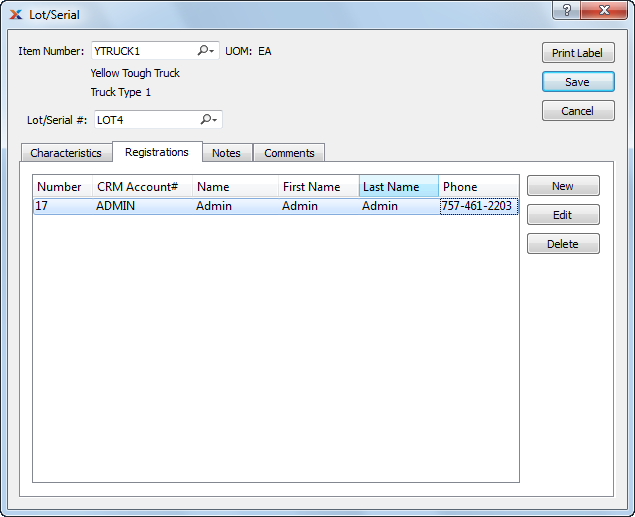
When registering Lot/Serial Numbers, you are presented with the following options:
Display lists registrations associated with the Lot/Serial Number.
To associate Notes with the Lot/Serial record, select the "Notes" tab. The following screen will appear:
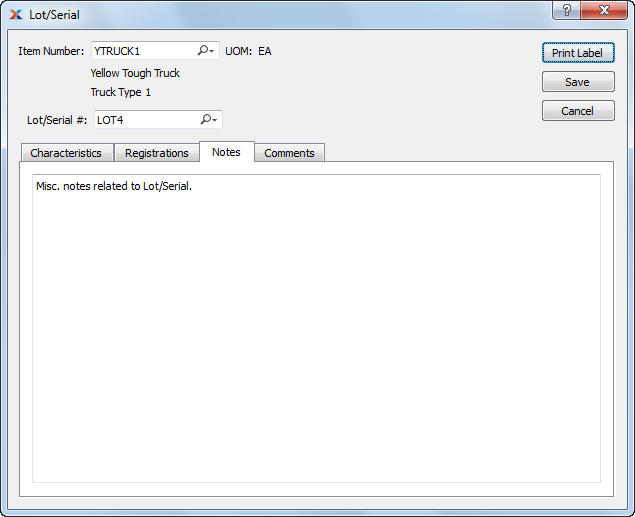
When associating Notes with a Lot/Serial record, you are presented with the following options:
This is a scrolling text field with word-wrapping for entering Notes related to the Lot/Serial record.
To create or view Comments related to a Lot/Serial record, select the "Comments" tab. The following screen will appear:
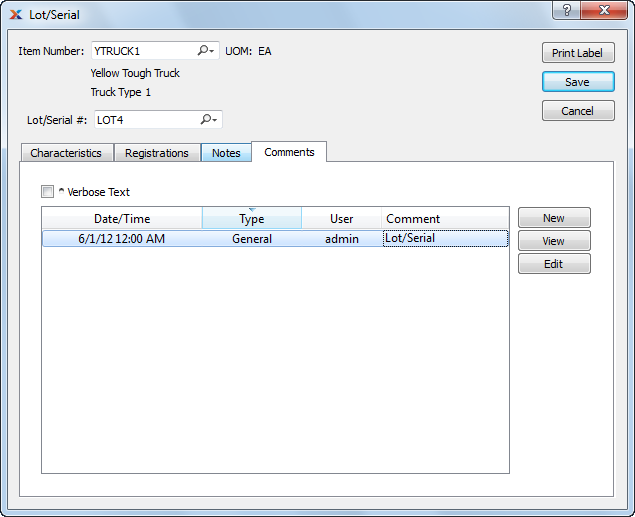
When adding or reviewing Comments, you are presented with the following options:
Select to display all Comments in the list in an expanded view which includes the entire text of each Comment. To edit a Comment, simply select the "Edit" link next to the Comment. That link will not be shown for Changelog Comments, which can't be edited. If the "Verbose Text" option is not selected, the Comment list will display only header level information for each Comment.
Display lists Comments related to the record.
The following buttons are available:
Opens screen for creating a new Comment.
Highlight a Comment and then select this button to reach a read-only view of the "Edit" screen.
Enables you to edit highlighted Comments—as long as the Comments are not "ChangeLog" Comments. ChangeLog Comments are system-generated and may not be edited. The edit screen is the same as that for creating a new Comment—except that when editing, the fields will contain Comment information. Double-clicking on a Comment will also bring you to the editing screen.
To enter a new Comment, select the NEW button. The following screen will appear:

Select a Comment Type from the drop-down list to classify the Comment. This is a required step. Comment Types may be system-defined (i.e., "ChangeLog" and "General") or user-defined, as described in Section 13.2.2, “Comment Types”. Once you have specified a Comment Type, begin typing your Comment in the main text area. The text area features word-wrapping and scroll-bar support for longer Comments.
The following buttons are unique to this screen:
Select to show the complete list (i.e., "thread") of Comments associated with the record. To hide the list, simply select the SHOW MORE button again. The Comment thread will show the most recent Comment first.
To associate documents with a Lot/Serial record, select the "Documents" tab.
When associating documents, you are presented with the following options:
Select to create a new document and associate it with the current record. You may create the following document types:
Select to create a new Image association.
Select to create a new Incident and associate it.
Select to create a new To-Do and associate it.
Select to create a new Opportunity and associate it.
Select to create a new Project and associate it.
Enables you to edit associated documents. The edit screen is the same as that for creating a new document—except that when editing, the fields will contain document information. Double-clicking on a document will also bring you to the editing screen.
Highlight a document and then select this button to reach a read-only view of the "Edit" screen
Select to associate already-existing documents. The following document types may be attached: Contact, Account, Customer, Employee, File, Image, Incident, Item, Opportunity, Project, Purchase Order, Sales Order, Vendor, Web Site, Work Order.
Highlight a document and then select this button to remove the association.
To associate already-existing documents, select the ATTACH button. The following screen will appear:
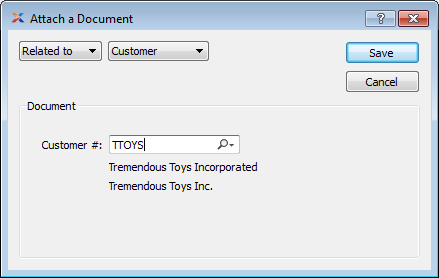
When associating already-existing documents, you are presented with the following options:
Indicate how the document is related to the current record. The following relationship options are available: Related to, Parent of, Child of, Duplicate of.
Specify the kind of document you want to associate. The following document types may be attached: Contact, Account, Customer, Employee, File, Image, Incident, Item, Opportunity, Project, Purchase Order, Sales Order, Vendor, Web Site, Work Order. When associating Files, you will also be given the option to save the File to the database.
There is no file size restriction when saving Files to the database. However, excessively large files could cause storage and performance issues.
Use the lookup field to identify the specific document you want to attach. The data entry options will vary depending on the document type you select.